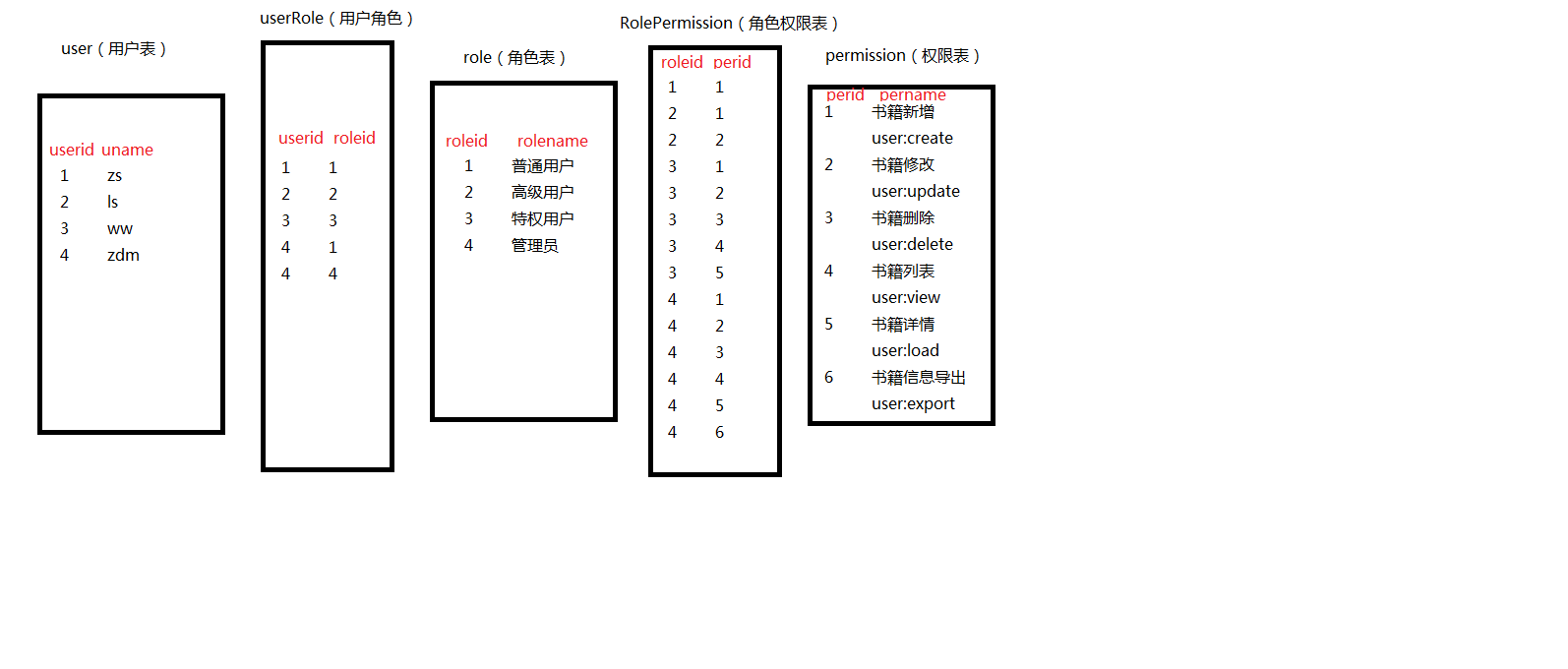shiro授权、注解式开发
Shiro授权
流程:根据前台传递管理的账号和密码进行认真,在跳页面前进行授权验证,看这个用户是否有这个权限。
今天的权限是由5张表构成的:

写两个查询方法:
<select id="getRolesByUserId" resultType="java.lang.String" parameterType="java.lang.Integer"> select r.roleid from t_shiro_user u,t_shiro_user_role ur,t_shiro_role r where u.userid = ur.userid and ur.roleid = r.roleid and u.userid = #{uid} </select> <select id="getPersByUserId" resultType="java.lang.String" parameterType="java.lang.Integer"> select p.permission from t_shiro_user u,t_shiro_user_role ur,t_shiro_role_permission rp,t_shiro_permission p where u.userid = ur.userid and ur.roleid = rp.roleid and rp.perid = p.perid and u.userid = #{uid} </select>
ShourUserMapper
Set<String> getRolesByUserId(Integer uid);
Set<String> getPersByUserId(Integer uid);
ShourUserService
package com.cjh.service; import com.cjh.model.ShiroUser; import java.util.Set; /** * @author * @site * @company * @create 2019-10-13 16:29 */ public interface ShiroUserService { /** * 用于shiro认证 * @param uname * @return */ public ShiroUser queryByName(String uname); int insert(ShiroUser record); Set<String> getRolesByUserId(Integer uid); Set<String> getPersByUserId(Integer uid); }
ShourUserServiceimpl
package com.cjh.service.Impl; import com.cjh.mapper.ShiroUserMapper; import com.cjh.model.ShiroUser; import com.cjh.service.ShiroUserService; import org.springframework.beans.factory.annotation.Autowired; import org.springframework.stereotype.Service; import java.util.Set; /** * @author * @site * @company * @create 2019-10-13 16:31 */ @Service("shiroUserService") public class ShiroUserServiceImpl implements ShiroUserService { @Autowired private ShiroUserMapper shiroUserMapper; @Override public ShiroUser queryByName(String uname) { return shiroUserMapper.queryByName(uname); } @Override public int insert(ShiroUser record) { return shiroUserMapper.insert(record); } @Override public Set<String> getRolesByUserId(Integer uid) { return shiroUserMapper.getRolesByUserId(uid); } @Override public Set<String> getPersByUserId(Integer uid) { return shiroUserMapper.getPersByUserId(uid); } }
MyRealm
package com.cjh.shiro; import com.cjh.model.ShiroUser; import com.cjh.service.ShiroUserService; import org.apache.shiro.authc.AuthenticationException; import org.apache.shiro.authc.AuthenticationInfo; import org.apache.shiro.authc.AuthenticationToken; import org.apache.shiro.authc.SimpleAuthenticationInfo; import org.apache.shiro.authz.AuthorizationInfo; import org.apache.shiro.authz.SimpleAuthorizationInfo; import org.apache.shiro.realm.AuthorizingRealm; import org.apache.shiro.subject.PrincipalCollection; import org.apache.shiro.util.ByteSource; import java.util.Set; /** * @author * @site * @company * @create 2019-10-13 16:19 * 认证过程 * 1.数据原(ini-》数据库) * 2.doGetAuthenticationInfo将数据库的用户信息个shbjet主体认证 * 2.1 需要在当前realm中调用service来验证,当前用户是否在数据库中存在 * 2.2 盐加密 */ public class MyRealm extends AuthorizingRealm { private ShiroUserService shiroUserService; public ShiroUserService getShiroUserService() { return shiroUserService; } public void setShiroUserService(ShiroUserService shiroUserService) { this.shiroUserService = shiroUserService; } /** * 授权 * @param principals * @return */ @Override protected AuthorizationInfo doGetAuthorizationInfo(PrincipalCollection principals) { ShiroUser shiroUser = this.shiroUserService.queryByName(principals.getPrimaryPrincipal().toString()); Set<String> roleids = this.shiroUserService.getRolesByUserId(shiroUser.getUserid()); Set<String> perIds = this.shiroUserService.getPersByUserId(shiroUser.getUserid()); SimpleAuthorizationInfo info=new SimpleAuthorizationInfo(); info.setRoles(roleids); info.setStringPermissions(perIds); return info; } /** * 认证 * @param token 从jsp页面传递过来的用户名和密码组成成的一个token对象 * @return * @throws AuthenticationException */ @Override protected AuthenticationInfo doGetAuthenticationInfo(AuthenticationToken token) throws AuthenticationException { String userName = token.getPrincipal().toString(); String pwd = token.getPrincipal().toString(); ShiroUser shiroUser = this.shiroUserService.queryByName(userName); AuthenticationInfo info = new SimpleAuthenticationInfo( shiroUser.getUsername(), shiroUser.getPassword(), ByteSource.Util.bytes(shiroUser.getSalt()), this.getName() ); return info; } }
注解式开发
@RequiresAuthenthentication:表示当前Subject已经通过login进行身份验证;即 Subject.isAuthenticated()返回 true
@RequiresUser:表示当前Subject已经身份验证或者通过记住我登录的
@RequiresGuest:表示当前Subject没有身份验证或者通过记住我登录过,即是游客身份
@RequiresRoles(value = {"admin","user"},logical = Logical.AND):表示当前Subject需要角色admin和user
@RequiresPermissions(value = {"user:delete","user:b"},logical = Logical.OR):表示当前Subject需要权限user:delete或者user:b
springmvc-servlet.xml中配置
<bean class="org.springframework.aop.framework.autoproxy.DefaultAdvisorAutoProxyCreator" depends-on="lifecycleBeanPostProcessor"> <property name="proxyTargetClass" value="true"></property> </bean> <bean class="org.apache.shiro.spring.security.interceptor.AuthorizationAttributeSourceAdvisor"> <property name="securityManager" ref="securityManager"/> </bean> <bean id="exceptionResolver" class="org.springframework.web.servlet.handler.SimpleMappingExceptionResolver"> <property name="exceptionMappings"> <props> <prop key="org.apache.shiro.authz.UnauthorizedException"> unauthorized </prop> </props> </property> <property name="defaultErrorView" value="unauthorized"/> </bean>
Controller层
/** * 身份认证的注解 * @param request * @param response * @return */ @RequiresUser @RequestMapping("/passUser") public String passUser(HttpServletRequest request, HttpServletResponse response) { return "admin/addUser"; } /** * 角色认证的注解 * @param request * @param response * @return * * 当方法必须同时具备1、4的角色id,才能被访问 */ @RequiresRoles(value = {"1","4"},logical = Logical.OR) @RequestMapping("/passRole") public String passRole(HttpServletRequest request, HttpServletResponse response) { return "admin/listUser"; } /** * 权限认证的注解 * @param request * @param response * @return */ @RequiresPermissions(value = {"user:update","user:view"},logical = Logical.OR) @RequestMapping("/passPer") public String passPer(HttpServletRequest request, HttpServletResponse response) { return "admin/resetPwd"; } /** * 身份、角色、权限认证失败后的处理方式 * @param request * @param response * @return */ @RequestMapping("/unauthorized") public String xxx(HttpServletRequest request, HttpServletResponse response) { System.out.println("错误!!"); return "unauthorized"; }
main.jsp
<ul> shiro注解 <li> <a href="${pageContext.request.contextPath}/passUser">身份认证</a> </li> <li> <a href="${pageContext.request.contextPath}/passRole">角色认证</a> </li> <li> <a href="${pageContext.request.contextPath}/passPer">权限认证</a> </li>
结果:直接进入会跳到错误处理页面,只有相关权限的才能进入

